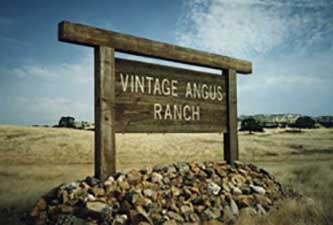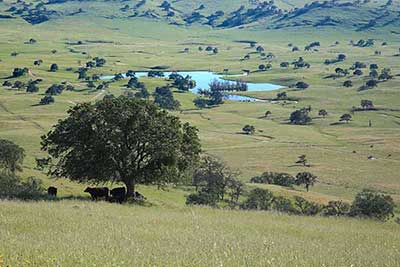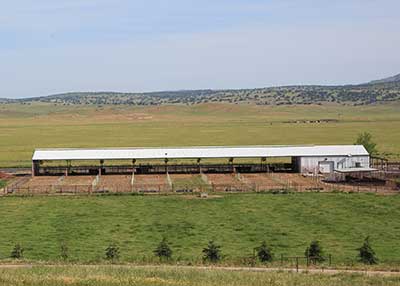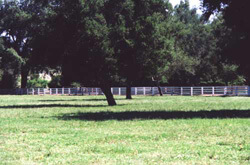The Ranch

Vintage Angus Ranch is made up of hill ranches located in and around the Modesto area in the central San Joaquin Valley. Vintage Angus Ranch is located in one of the few parts of the world that a year-round grass ranch can operate. In the fall of the year until late spring, the Vintage herd is at our foothill ranch, which is green all winter. Then, in the late spring we move our herd to the valley to run on green pasture all summer. This unique situation has brought our focus toward cattle that are efficient and sound so they can cover the country to forage.

The La Grange Ranch
The foothill ranch (also referred to as the Bloss Ranch) is located four miles east of La Grange, CA. The ranch encompasses more than 7,000 acres and the home for the entire Vintage herd from November 1st to June 1st. The Bloss Ranch is also the home for the Sierra-Bloss commercial cow herd, which is owned by Tim Coleman. The foothill ranch is made up of gently rolling to steep terrain and supports a wide variety of annual native grasses, which grow primarily through the winter season. The ranch also supports a large variety of oak trees and wildlife that comprise of deer, quail, dove, eagles, hawks, bobcats, mountain lions and coyotes. The Bloss ranch is also home to our annual "Carcass Maker" bull sale that is held the first Thursday in September of each year. Vintage Angus Ranch and all of its employees take pride in operating the native ranch with a stewardship that will not only increase grass and beef production but also enhance the environment of the wildlife population.

The Warnerville Ranch
The Warnerville Ranch is located in Waterford, CA, just outside of Modesto. The Warnerville Ranch is the irrigated property and the home for our donor cow program and the development center for our bulls. The donor cows are maintained in a new facility built to house cows during the flushing period. After each flush, the cows are returned to the pastures until their return in the rotation. The entire ranch is fenced so that the cattle are managed in a rotational grazing system. The bulls are grown out in large pens to insure they’re sound and ready for sale.
The Warnerville Ranch is also home to our spring calving herd. Cows are run on this ranch utilizing a rotational grazing that uses a high density, short duration system. The bull calf pairs are separated from the heifer calf pairs and are run in their respective contemporary groups through weaning. These grass raised calves do not receive any additional supplementation through the spring and summer months, except a complete mineral.

The Scenic Ranch
The Scenic Ranch is located on Scenic Bend in Modesto and is the smallest of all the properties. The ranch is also the site for our Annual Female Production Sale on the 2nd Sunday in October. It is the site of our company office and the home of owner James E. Coleman.
The ET Program
The embryo transfer (ET) program is the heart of the breeding system here at Vintage Angus Ranch. The donor cows are housed and run at our Warnerville Ranch during the time that they are being flushed. Once each of the cows are bred back, they are returned to the main herd of cows until they calve again. The donor program is based around some of the most proven predictable cow families in the Angus breed. We are also able to produce a bank of embryos that we offer for sale and a current listing can be requested on the Contact Us page.

The Cow Herd
The spring calving cow herd is the larger of the two groups of cows. This group of cows begin calving January 1st. These cows calve on the La Grange ranch and AI season begins on the hill ranch, and then they are moved to the irrigated ranches in May. The calves are weaned in the fall and the pregnant dry cows return to the La Grange ranch, to start the cycle all over again.
The fall calving cowherd calves between mid-August and October 1st. These cows are managed throughout the year on the La Grange ranch with some supplemental hay feeding required due to the fact that the ranch receives no rain from May to November.
Ranch History
Jim Coleman's interest in cattle was sparked by his uncle, Herb Coleman, on his many visits as a boy to his uncle's Jersey dairy. He was a leading dairyman in Oregon and was president of the Oregon Jersey Association. There was something noble and unique about Herb’s work which instilled a set of values that Jim maintains. In later years of Jim's business career, an opportunity arose for him to have his own herd of cattle and to rediscover that farming was in his blood.
Two of Jim's four sons worked one summer on a commercial Angus ranch where his family's company conducted feed experiments. They came home to return to high school and said to their dad, "We should have some Angus cattle around our home ranch." Jim said, "If you build the fence, I will buy the Angus cows."
So, the boys persuaded him to go to Ankony Angus in Loyalton, CA, to buy some cows. This was an important milestone because it led to the friendship of Mac Cropsey and Armand Hammer and the first purchase of four females from their first California sale in 1976 and the beginning of Vintage Angus.
During the following years, Jim learned the importance of cow families and all the important aspects of breeding Angus cattle from these men, along with Bob Long and Chuck Graff. Two of the most important cow families from the Ankony herd are still represented in Vintage's exceptional list of donor cows.
As Jim's sons grew past the junior projects, his next two sons took up the helm and spurred the program along into the 1980s. During these years, the Vintage herd increased in size and quality and started their annual female production sale in the fall of 1987. It wasn't until Jim decided to expand from a regional to a national program and to reach out for a nationally known manager that the next major milestone was achieved.
Jim hired Doug Worthington as manager of Vintage Angus in 1989. Doug's beef cattle experience, particularly Angus cattle, spans over a lifetime of involvement, as he was raised in a family heavily committed to the business. His dad managed Angus operations, and Doug learned the ropes over the years helping out with all phases of running a purebred operation. Impressively, in 1985 he won the American Angus Association's 1985 National Herdsman Award. Vintage has benefited greatly from teaming up the best mind in the Angus world with the best business mind of Jim's to make an unbeatable combination. The results speak for themselves.
During the 1990s, the cow herd increased to 400 cows with constant gains in quality, proven donors and superior cow families with predictable bloodlines. In the early 1990s, the ET program was expanded, and its breeding program was one of the first in the country to demand improved carcass quality by selecting only sires that had positive marbling and ribeye EPDs. As a result, the herd average shows four to five generations of carcass-tested cattle in their pedigrees. This achievement and proven ability to produce superior bulls set the stage for their first bull sale in 1994 at their new Sierra foothill ranch in La Grange. Those commercial cattlemen who got behind a premium quality beef program or an alliance found the Vintage range bulls a perfect fit to meet the high carcass specifications. The demand for range bulls with high carcass traits has made their September Carcass Maker Bull Sale one of the highest sale averages in the West.
Following closely at the heels of the bull sale is the female production sale always held the second Sunday of October. Angus breeders come from all over the country to attend because the already high quality gets better and better every year. This is a result of knowing the genetics of the herd and the ability to use the latest technology, including DNA and ultrasound data, to continue to improve it and keep it on the cutting edge of the Angus breed. Their loyal customers have made it a top sale, and a true highlight on the Angus sale calendar.
Jim's desire from the beginning was selecting only the best cows and sires from the best cow herds in the country. Being persistent, working toward the ranch goal year in and year out, despite all kinds of changes in the breed, has been rewarding and the cornerstone to the success of the Vintage program. His goal is to have all the vital and economically important traits found in his Angus herd when the DNA traits are identified, and the genome of Angus cattle is determined. His vision of "producing the ultimate Angus genetics" will then reach a new scientific plane that will have enormous benefits to the industry and the consumer.
